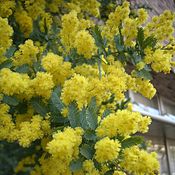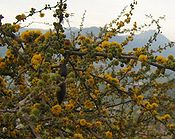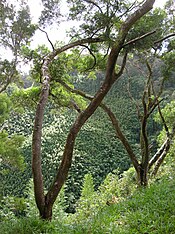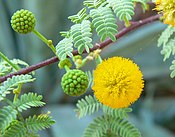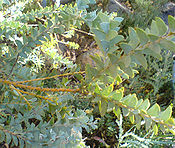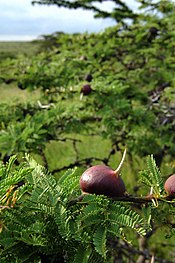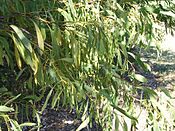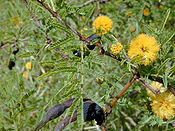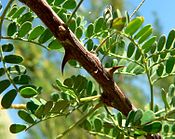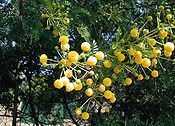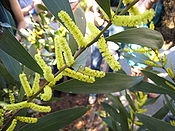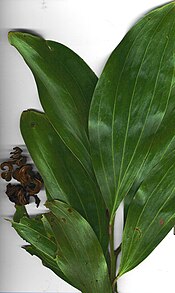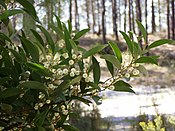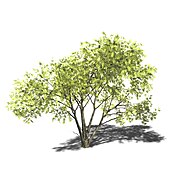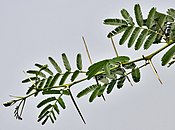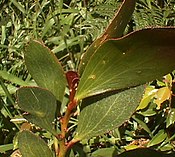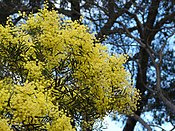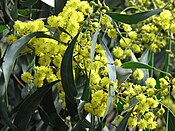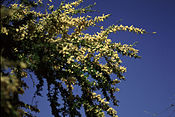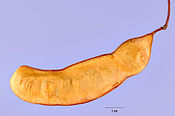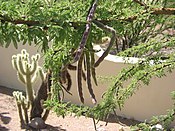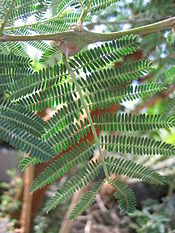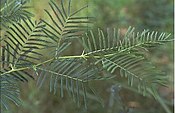Acacias known to contain psychoactive alkaloids
This section may require cleanup to meet Wikipedia's quality standards. The specific problem is: Should update to current nomenclature for genus moves.(April 2022) |
| 0.04-0.82% alkaloids in leaves and stems, 0.08% in ripe pods, mostly phenethylamine [1] | |
| DMT in bark (up to 1.6%) and in leaves (0.6-1.0%), young leaves mainly containing tryptamine; [2] 0.72% alkaloids from leaves and stems, mostly tryptamine [3] | |
Acacia burkittii (syn. A. burkittii) | DMT in bark (0.2-1.2%), 0.1% alkaloids from leaves (mostly NMT); [4] 1.5% alkaloids from leaves and stems, mostly tryptamine [5] |
| β-methyl-phenethylamine (N-methyl-phenethylamine), 2.4% in leaves; [6] 3.2% alkaloids in aerial parts (stems, leaves, flowers) - about 70% was β-methyl-phenethylamine, with smaller amounts of phenethylamine [3] | |
| Published reports of DMT in the leaf [7] derive from a misreading of a paper that found no DMT in leaves of this species. [8] Besides this, there are independent claims of DMT in leaves and bark based on human bioassay, [2] and traces of 5-MeO-DMT, DMT and NMT were tentatively identified by TLC in twigs. [9] Root bark contains alkaloids that were not identified [10] | |
| Dimethyltryptamine active levels in leaf [11] [ unreliable source? ] | |
| Ash used in Pituri. [12] Ether extracts about 2-6% of the dried leaf mass. [13] Not known if psychoactive per se . | |
| 0.028% β-methyl-phenethylamine in leaves, [14] DMT (0.00012-0.00102%) and N-methyltyramine (0.00011-0.005%) in leaves; [15] DMT and 5-MeO-DMT tentatively identified by TLC from roots in one test, not detected in follow up; 5-MeO-DMT tentatively identified by TLC in seeds [9] | |
| Has been claimed to contain tryptamine alkaloids [16] and significant amount of tryptamine in the seeds, [17] but this needs confirmation and supporting information | |
| 5-MeO-DMT tentatively identified in stem bark [9] | |
| 0.02% alkaloids in spring (80% tetrahydroharman, 20% tryptamine), 0.028% autumn (tryptamine) and none in summer, with leaves of Californian plants; [18] traces of DMT and unidentified indoles tentatively detected in seeds [9] | |
| Claimed to be psychoactive, [19] but supporting information is needed. Ash used in pituri [12] | |
| Hordenine, tyramine and N-methyltyramine in leaves; [20] 0.28-0.66% N-methylphenethylamine in leaves. Causes stock intoxications in Texas. [14] [21] Claims of amphetamines, mescaline, nicotine and many other alkaloids [22] are suspect [23] | |
| 0.65% alkaloids from leaves and stems, 0.58% from pods and 0.09% from seeds, mostly phenethylamine [1] | |
| Tryptamine and DMT N-oxide from bark [24] | |
| 0.02-0.06% alkaloids from stems and leaves, consisting of tryptamine and phenethylamine; [3] one screening found no alkaloids [25] | |
 Acacia catechu (syn. A. polyacantha, A. suma) | Claims of DMT in the plant [26] have been referenced to works that do not support the claim. Needs research. |
| Claims of tryptamines in this species are unreferenced. Leaves of this (and/or other plants) and tobacco, are occasionally smoked with Anadenanthera seeds for psychoactive effects [27] | |
Acacia chundra (syn. A. catechu var. sundra) | Claims of DMT and other tryptamines in leaf and bark are unreferenced. Needs research. |
| Claimed to contain up to or more than 1.8% DMT in bark, 0.2-0.6% in leaf, [28] Requires further confirmation. | |
| 0.3% N-methyl-tetrahydroharman, traces of tetrahydroharman in leaf and stem; [29] independent claims of DMT from bark [30] need confirmation | |
| 2.1% Nicotine (w/w), 1.2% calycotomine (d/w) from leaves [31] [32] | |
| 0.074% alkaloids from stems (20% DMT, 80% NMT); [33] NMT and an unidentified tryptamine alkaloid from trunk bark; [34] [35] 2.85% alkaloids from root bark (45% DMT, 55% NMT); [36] 0.005% DMT, 0.009% DMT N-oxide, 0.006% NMT and 0.007% N-chloromethyl-DMT (might be artefact of extraction) from unspecified parts [37] | |
| 0.02% alkaloids from leaves, including β-methyl-phenethylamine (tentatively identified) [14] | |
| Ash used in Pituri. [12] [38] Not known if psychoactive. | |
| May be psychoactive, as the root is used as an aphrodisiac, and may have been added to the Central American balché beverage. [27] Claims of tryptamines in this species [39] might be speculation. Research needed. | |
| 0.02-0.07% alkaloids in leaves and stems, including tryptamine (tentatively identified) and a phenethylamine. 0.04% alkaloids in seeds and unripe seed pods; [1] [3] [40] tentative observation of 5-MeO-DMT in leaves, stems and flowers [9] | |
| Has been included on a list of psychoactive plants, [19] but requires supporting information | |
| Has been included on a list of psychoactive plants, [19] but requires supporting information | |
| DMT in bark (up to 1.4%) and leaves (0.5-0.8%), young leaves mainly containing tryptamine [2] | |
| Psychoactive, [19] but less than 0.02% alkaloids [41] | |
| Tentative identification of 5-MeO-DMT and an unidentified β-carboline from immature seed pods; [9] tryptamine in stem bark. [24] A claim of β-methyl-phenethylamine from flowers is not supported by the reference given. [42] Ether extracts about 2-6% of the dried leaf mass. [13] Alkaloids are present in the bark [43] and leaves. [44] Others found no alkaloids. [25] Claims of amphetamines and mescaline in the tree [39] appear to be groundless | |
| Has been added to pulque, [27] but its psychoactivity is unknown | |
| Up to 0.18% alkaloids from tops, mostly tryptamine with some phenethylamine; 0.15-1.18% alkaloids from flowers, equal amounts tryptamine and phenethylamine; [40] [45] traces of unidentified alkaloid from bark. [1] Recently found to actually contain mostly DMT (up to 0.1% from leaves, 0.3-0.5% from bark), with bark also containing NMT, and small amounts of tryptamine, harman and norharman [2] | |
| 0.016% alkaloids from leaves, including (tentatively identified) N-methyl-β-phenethylamine and tyramine [14] | |
| 0.1-0.6% alkaloids in leaves, consisting of phenethylamine and hordenine at a ratio of 2:3; 0.3% alkaloids in bark [6] [25] | |
| Hordenine, 1.2% in bark [6] | |
| Has been claimed to be psychoactive, but this is not supported by the reference given [38] | |
| Claimed to be psychoactive, [46] but this requires supporting information | |
| Putative species claimed to contain DMT and NMT, without a reference; possibly assumed due to supposed use in jurema wine | |
| Probably psychoactive; roots used in Zimbabwe as an aphrodisiac and to treat dizziness, convulsions and body pains [47] | |
| Used in Pituri, but not known if psychoactive. [38] | |
| 1.3-1.88% alkaloids from leaves and stems, mostly (92%) phenethylamine; [3] 0.9% β-methyl-phenethylamine from leaves [6] | |
| Published reports of DMT in the leaf [7] derive from a misreading of a paper that found no DMT in leaves of this species. [8] Needs research | |
| Tryptamine in root bark [24] | |
| Used in Pituri, but not known if psychoactive. [27] | |
| 0.2-1% alkaloids from tops, 0.14-0.29% from flowers; consisted mostly of tryptamine-like alkaloids (tryptamine itself found in some flowers), with small amount of phenethylamine. [1] [40] [45] Some strains have been found to contain up to 0.2% DMT in unspecified parts. [2] [48] Leaves, bark, pods, seeds and flowers all contained varying levels of histamine amides [49] | |
| Contains alkaloids in leaves, stems and unripe seed pods [25] [40] but they have been poorly investigated. A claim of tryptamine in leaveand bark [17] requires a proper reference. Several reports of DMT content unconfirmed [2] [50] | |
| Claimed to contain tryptamine, [17] but without a reference. Needs research | |
| 0.13-0.71% alkaloids from bark, consisting of NMT and DMT in about a 2:3 ratio; [25] [51] both also present in leaves. Some varieties of the species are not good alkaloid sources. [2] Tentative identification of 5-MeO-DMT in wood and twigs, NMT in root [9] | |
| Rumoured to contain DMT or similar psychoactive alkaloids [2] | |
| Some plants may contain DMT in the bark and leaf, but may have been misidentified as most do not. [2] Traces of alkaloids detected in bark, leaf and seed; sometimes no alkaloids [1] [25] | |
| Published reports of DMT in the leaf [7] derive from a misreading of a paper that found no DMT in leaves of this species. [8] Needs research | |
| DMT, NMT, tryptamine, other alkaloids [52] | |
| One published report of DMT in the leaf [7] may derive from a misreading of a paper that found no DMT in leaves of this species. [8] Later analysis tentatively found 5-MeO-DMT in stems, leaves and roots; DMT, NMT and 5-MeO-DMT were tentatively observed in seeds, but follow-up tests were negative. [9] [53] Bark contains unidentified alkaloids [54] Bark in one sample subsequently found to contain an alkaloid which has an Rf value suggesting DMT. [55] | |
| Acacia nilotica subsp. adstringens | DMT and Harmane derivatives [56] |
| 0.15-0.6% alkaloids from bark, 0.07% from fresh tips, [2] [25] [57] 0.15-0.3% from dried leaves. A small population seems to contain mainly DMT in bark, with most also containing other alkaloids including NMT, tryptamine, harman and norharman; leaves may contain more NMT than DMT. Some assays showed tentative presence of 5-MeO-DMT and/or bufotenine but these are unconfirmed and other assays did not detect them [2] [58] [59] | |
Acacia oerfota (syn. A. nubica) | 0.016% DMT in leaf; [8] a claim of NMT in this species is unreferenced |
| Claimed to be psychoactive, [19] but supporting information is needed. Bark and leaves have been used to poison fish [60] | |
| 0.3% DMT in leaf; [61] a claim of NMT [11] could not be found in the reference given and needs verification. Species is rare and threatened | |
| 0.11-0.29% alkaloids in leaves and stems, 0.11% from seeds and pods, mostly tryptamine and sometimes with phenethylamine also present; [1] [3] [40] a later analysis found 0.06% tryptamine from leaves (w/w) [62] | |
Acacia polyacantha ssp. campylacantha (syn. A. campylacantha) | 0.004%% DMT in leaf; [8] claims of NMT and other tryptamines in leaf and bark [63] are not supported by the reference given |
| Up to 0.44% alkaloids from leaves and stems, mostly phenethylamine [40] | |
Acacia prominens (syn. A. praetervisa) | 0.17-0.65% alkaloids from stems and leaves, 1.8% from flowering tops, consisting of phenethylamine and β-methyl-phenethylamine [1] [3] [40] [64] |
| Ash used in Pituri. [12] [38] Not known if psychoactive. | |
| 0.02-0.09% alkaloids from stems and leaves, [40] 0.04% from tops, mostly tryptamine with some phenethylamine [45] | |
| Less than 0.01% total alkaloids in leaf, [40] sometimes none. [25] 0.4% DMT in single tree [65] | |
| 0.01% Nicotine was reported from leaves, but identity of the plant was not certain; [66] claims of DMT and NMT in the plant [67] require verification or a proper reference | |
| 0.025% alkaloids from leaves, including N-methyl-phenethylamine and N-methyl-tyramine (both tentatively identified). [14] Claims of DMT, NMT, amphetamines, mescaline, nicotine and many other alkaloids [68] are suspect [23] | |
| 0.036% alkaloids from leaves, including β-methyl-phenethylamine, tyramine and N-methyl-tyramine [14] | |
| Ash used in Pituri. [12] [38] Not known if psychoactive. | |
| A claim of β-methyl-phenethylamine, phenethylamine, amphetamines and mescaline in this species [39] lacks a reference and is highly dubious | |
| β-methyl-phenethylamine in leaves, tentatively identified [14] | |
 | 0.003% DMT in leaf; [8] claim of DMT in bark [17] requires verification |
| Published reports of DMT in the leaf [7] derive from a misreading of a paper that found no DMT in leaves of this species. [8] Ether extracts about 1-7% of the dried leaf mass. [13] | |
| Published reports of DMT in the leaf [7] derive from a misreading of a paper that found no DMT in leaves of this species. [8] However it is rumoured that unpublished analysis has found DMT in the plant [2] | |
Acacia simplex (syn. A. simplicifolia) | 3.6% alkaloids from leaves and stem bark (40% NMT, 22.5% DMT, 12.7% 2-methyl-tetrahydro-β-carboline, and traces of N-formyl-NMT which might be an artefact of extraction) [69] |
| 0.21-0.35% alkaloids from leaves and stems, about 2/3 phenethylamine [3] | |
| Up to 0.89% alkaloids from leaves and stems, 0.05-0.17% from unripe pods, mostly phenethylamine [1] [40] | |
| 0.008% alkaloids from leaves including β-methyl-phenethylamine and tyramine (tentatively identified) [14] | |
| Published reports of DMT in the leaf [7] derive from a misreading of a paper that found no DMT in leaves of this species. [8] Needs research | |
| Tryptamine, in the leaf and stem (up to 83% of total alkaloids); alkaloid content was highest in autumn and spring (0.12-0.28%), lowest in summer and winter (0.03-0.08%) [3] | |
| Tentative positive for DMT in aerial parts of a 1 yr old plant, and 5-MeO-DMT in roots of 2 yr old seedlings; [9] a formal screening found no alkaloids in leaf and stem. [25] Appears to contain DMT based on human bioassays [2] |





